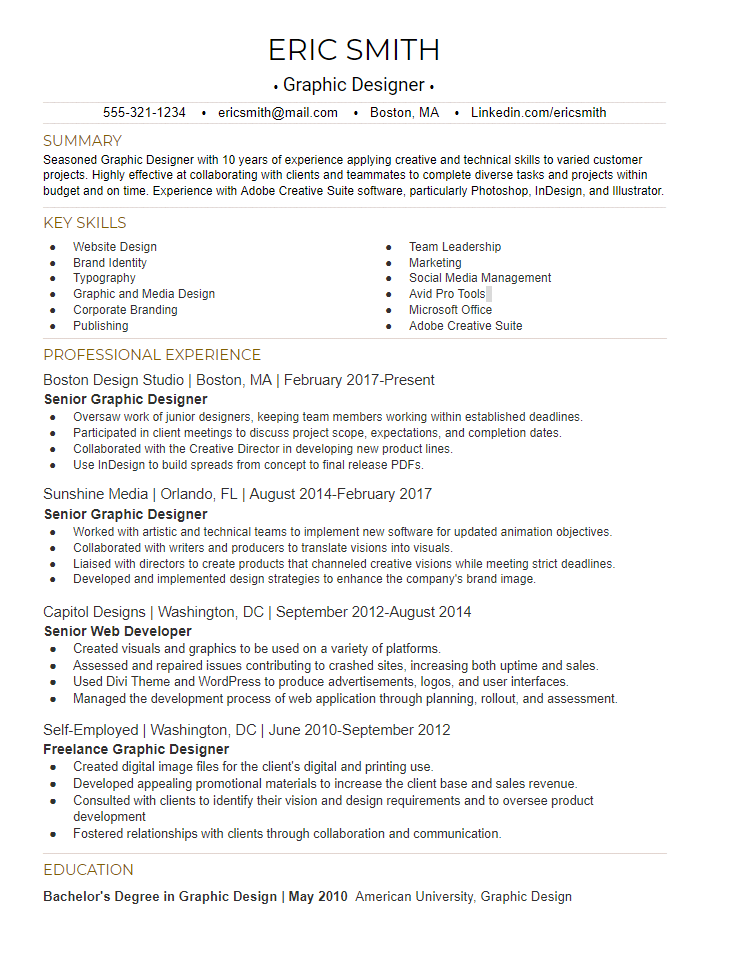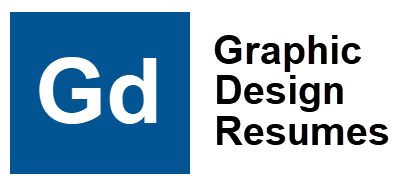Graphic Designer Resume Sample
When applying for a job as a graphic designer, employers will want to see a strong resume filled with relevant experience, skills, and training. They will also be looking for a specific format in order to learn about you and determine if you are a good fit.
Below is a comprehensive guide to creating the perfect resume to land your dream graphic designer job.
Things to Keep in Mind When Writing Your Resume
In order for a potential employer to quickly get a sense of your qualifications for your desired position, your resume should be:
Organized: Clearly label each section of the resume to make it easy for the reader to quickly find information.
Succinct: Choose your words carefully to avoid using cliches and redundant language. Your resume should also ideally fit on one page; if it takes up more than two pages, you will want to edit it down.
Tailored: Although your education and experience will remain consistent, be sure to tailor the skills and summary for each specific position. Address any requirements or responsibilities included in the job description within your resume.
Demonstrable: Be prepared to back up anything you claim in your resume within your portfolio or in an interview. Do not imply skills or training that you think might help you land the job. Instead, highlight your strengths and let your experiences and training speak to your hard work and dedication.
As noted above, your graphic designer resume should be separated into clearly labeled sections which appear in a certain order within your resume. Here is more specific information about how to structure each of these sections.

Section 1: Your Contact Information
The first section of the resume should include your name and information in order for the employer to follow up with you. Typically, this section should include your name, home address, telephone number, and email. You can also include a professional social media account, such as LinkedIn or Instagram, if these provide more information about your work as a graphic designer.

Overall, make sure that your information includes professional means of contact only. Your email address and any social media links should be appropriate and showcase you as a serious candidate for the position.
Section 2: Your Summary
The best place to connect your strengths and purpose with the goals of the organization is in the summary section. Here, you will highlight your most pertinent experience, skills and training that make you a good fit for the position. This section should include 2-4 concise sentences that pull from each of the subsequent sections.

You do not need to go into too much detail in the summary. You will give more specifics in the following sections. Remember, this part of the resume is intended to grab the reader's attention and encourage them to continue reading and learning more about you as a potential employee.
Section 3: Core Competencies
Once employers begin delving deeper into the specifics of your qualifications, they will want to know more about your foundational skills. These are typically listed in a bulleted format in order for the reader to quickly scan. Include 12-15 skills in this section, and ensure that they are succinct and clear.

It is important to refer back to the job posting when writing this section of the resume. Many organizations now use ATS, or applicant tracking software, in order to filter out resumes for a human reader. Including some of the target skills in this section will help ensure that your resume is retained and passed along to the right people.
Section 4: Professional Experience
Another key section of the resume is your list of your relevant graphic design experience. Begin with your most recent position and work backward. For each job that you have held, list your title, the organization, their city and state, and the dates that you worked there.
Underneath, include 1-2 sentences that summarize your role within the company. This information gives the reader an idea of the type of work you have done and your main responsibilities in the role.

Next, include a bulleted list of your most notable and applicable responsibilities, achievements, and skills within that role. In addition to letting them know that you excelled at your job requirements, this is your chance to show how you improved the organization through your employment. For example:
You developed a client feedback process that directly improved customer satisfaction
You proposed and created a new layout template that was utilized by your firm
You won an award for a magazine cover that you designed
Although you may be tempted to include a long bulleted section, cultivate your list carefully. While extensive experience in the field can bode well for your qualifications for the position, too much information can bog down this section and make it difficult for the reader to determine your most applicable prior work. In the bulleted portion, include only the most relevant skills and responsibilities to those listed in the job posting.
Section 5: Education and Certifications
The last section of your resume should include any degrees that you have earned or special certifications that you have obtained. For your education experiences, list the degree, the school where you completed it, and the year of graduation. If you earned a certification or completed a specific course within this pathway that could be relevant to the position you are seeking, you can bullet this information underneath.

For any specialized training that was obtained separately from your degree, list the title of the certification, the institution through which it was completed, and the date. You can also bullet any pertinent information about the degree below.
Putting It All Together
When all of the parts of the resume come together, it should appear neat and precise. It is advisable to read through the resume several times to catch any errors. Asking a trusted friend or colleague to read through your resume will also provide feedback to ensure it reads professionally and cohesively.

To help guide your final review, ask yourself these questions:
- Did you use strong, action-based language throughout?
- Were you consistent with the tense?
- Did you use proper grammar from top to bottom?
- Are there area where you could cut out words to make things simpler and easier to understand?
- What bullet points still include unquantified activity? Can you add some numbers to those?
Finally, the BIG question... does your graphic design resume tell your story, clearly and concisely?
If the answer is an unqualified "Yes!" then you should be good to go.
If not, then perhaps now would be a good time to reach out for some professional help.
